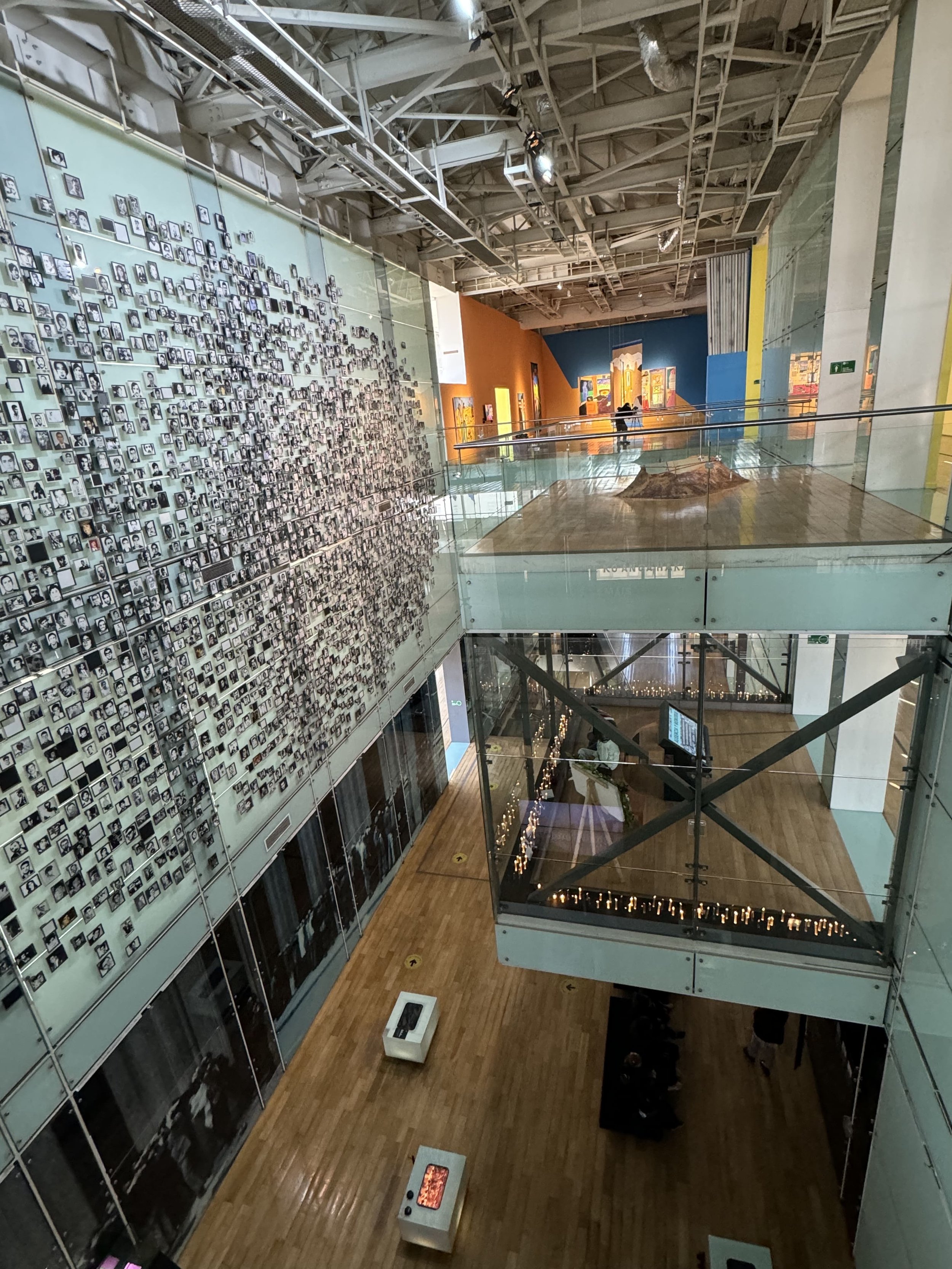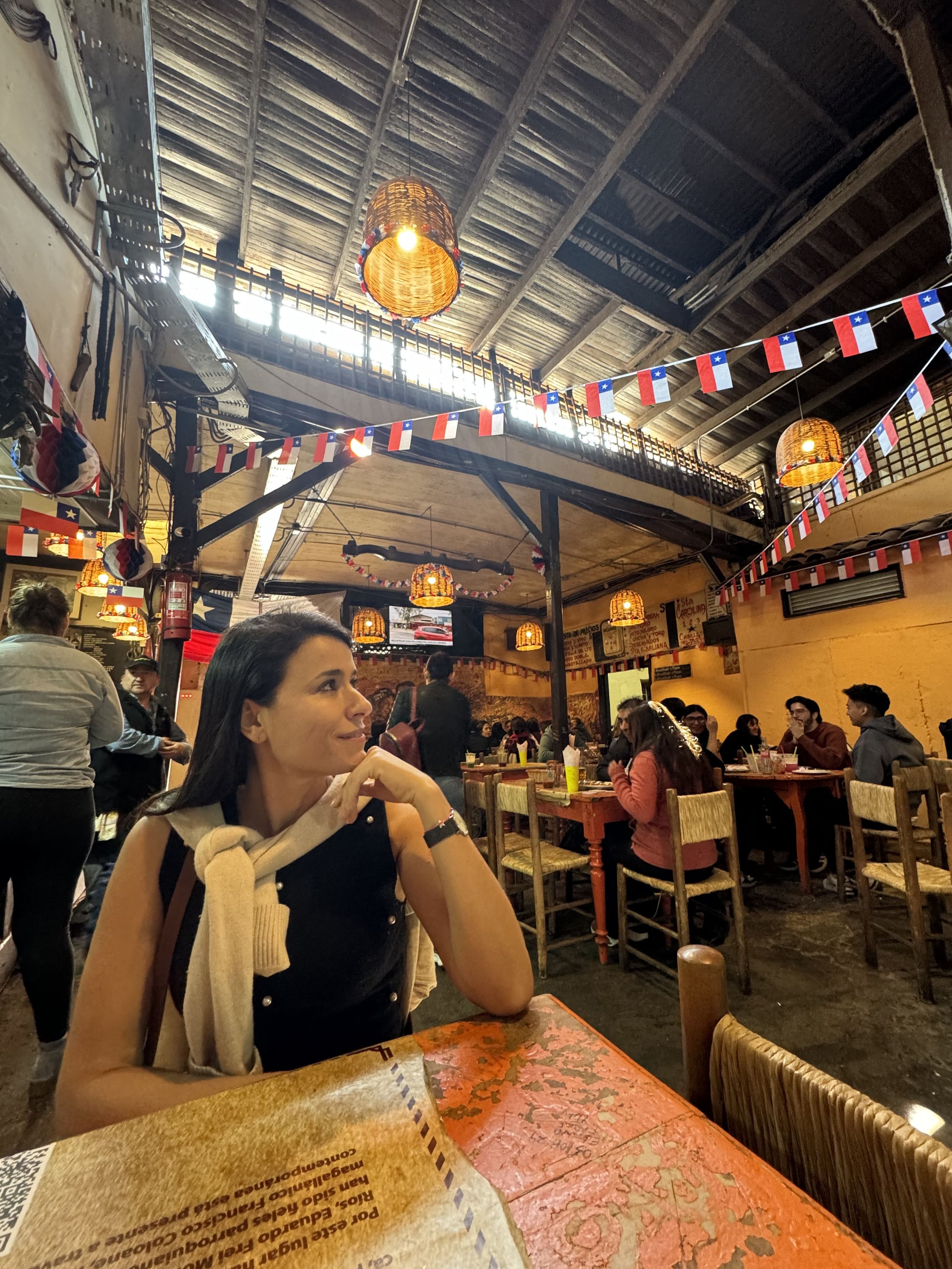Santiago de Chile
Contrasts by the AndesA long weekend was tempting for a three-day getaway to Chile's capital.
From Salta we got a convenient connecting flight via Buenos Aires, but it did not allow us to cross the mountain range clearly because it was at night time that we landed at Arturo Merino Benitez International Airport, and although the moon was full and we could see its immensity, it must really be incredible to cross it during the day.
A strike that night by the Migration staff meant that the process took more than half an hour. When we left, we asked for an Uber, which with all the commotion that was going on those days before the national holidays was quite expensive.
The trip happened to fall on the celebration of the Republic's anniversary, so everything was decorated with flags and we could feel the civic celebration in the air.
A clarification: by then Uber was forbidden in Chile, so the meeting point was a bit complicated for us. But we made it.
A trip of more than half an hour took us to the Regal Pacific Las Condes hotel. A five-star hotel with its years, but very conveniently located right in front of the Manquehue subway station.
It was already late so we went straight to rest in the very spacious room we were assigned with a view of the avenue and the Andes mountain range.
The next morning, we took advantage of the varied breakfast offer and enjoyed ourselves to the fullest.
Then we went to the subway to start our tour. We bought the bip card that would allow us to move in public transport, then we went down to the platform to take the modern subway.
We made a combination of lines in Baquedano to continue on L5 to Quinta Normal.
This is the station that connects to the Museum of Memory and Human Rights, which focuses on the recent history of Chile.
Its official website informs that it is one of the most important museums in Santiago de Chile and its visit is essential to understand the history of the country, as it is dedicated to preserve the memory of the victims of the military dictatorship that took place in Chile between 1973 and 1990, as well as to promote education and respect for human rights.
It is public and free of charge. It was inaugurated by President Michelle Bachelet on January 11, 2010, as part of the governmental works celebrating Chile's Bicentennial.
When we left, we boarded a bus that took us directly to the center of the city to start a tour of the main public buildings, discovering its beautiful architecture.
It was there when we noticed the first contrast, the downtown area, much more neglected, with people living on the streets, with its dilapidated buildings, very different from the neighborhood of our hotel, more modern and upper-class. In addition, the locals insisted we walk carefully to avoid robberies or bad moments.
We took pictures in La Moneda, the Presidential Palace, seat of the Government of Chile, a neoclassical building of the nineteenth century, built between 1786 and 1812. Its name is due to its original function, as it was a coins minting center.
We passed by its La Moneda Cultural Center, without entering because we were not tempted by the temporary exhibition offered and walked along the Paseo Ahumada to the Santiago Stock Exchange, to admire its architecture.
Then it was time for the Municipal Theater of Santiago. It is the opera house, designed in a clear French neoclassical style. Just in front, in the square, is Fuente de los Niños. (Children's Fountain). A work that was given by the Argentine Republic on the occasion of the First Centenary of the Independence of Chile in 1910, by sculptor Arturo Dresco.
We returned along Paseo Ahumada, crossing the arcade of the Pre-Columbian Art Museum, to the Palace of Justice and on the other side of the street the former National Congress - Company of Jesus.
Then it was time for the lively Plaza de Armas. The Cathedral of Santiago and the National History Museum stand out. As there were celebrations everywhere, the museum was no exception, there they were dancing the cueca generating a very nice atmosphere for tourists. Admission is free and we found the exhibition of antique objects very interesting.
A walk along the colorful Paseo Bandera towards the market area followed, but first a mandatory stop at La Piojera, the traditional restaurant, which evokes the customs of yesteryear and where they serve the “terremoto”, the representative cocktail of Chile, a mixture of white pipeño wine with pineapple ice cream and grenadine or fernet. Strong and sweet.
When we finished we headed to the Central Market, with fish and seafood displayed for the diner and where a super feast awaited us. We knew that lunch at Santiago's most traditional market was an attraction in itself. And the waiters quickly convinced us to take a table at Don Augusto and order a spider crab. We started with the crab cake. Delicious. And for the main course came the queen of the cold seas. Its white meat is soft and lean. It is accompanied with garlic oil that gives it great seasoning.
Then we walked a few blocks to the National Museum of Fine Arts, with free admission. It has a permanent exhibition with works by Chilean artists. It was inaugurated in 1910, also on the occasion of Chile's centennial. The Palace is joined to the Museum of Contemporary Art, both in the Forestal Park.
Very close to there is Santa Lucia Hill, very small, so it is very easy to walk to the top, has a great historical value in the city. It is a French style park in the heart of Santiago. It is 69 meters high. It highlights the Hidalgo Castle and the beautiful Neptune Fountain. The panoramic view of the snow-capped peaks of the Andes is extraordinary.
On our way out, we took the subway to Providencia neighborhood. We wanted to visit the modern Tobalaba Urban Market and then the Costanera Center. A huge shopping mall accessed by Vitacura Avenue. The amount of people strolling through its stores and aisles was indescribable, but we still managed to do some shopping.
At sunset, we had planned to go up to the Sky Costanera Center. The Costanera Center Tower is the tallest skyscraper in South America. Its observatory has a 360-degree panoramic view of Santiago. So visiting it at sunset is an attraction. And it was. Super entertaining to see the whole city light up as much as the top structure of the tower itself. The viewpoint, 300 meters high, has a glazed observation platform on the 61st floor and an open sky on the 62nd floor. The access ticket is purchased in the lobby of the Costanera Center Mall.
There we decided to have a nice drink while enjoying the glorious sunset with the Andes on the horizon. Beautiful!
The next day, we decided to visit the huge Parque Arauco, shopping mall, very close to Parque Araucano, in Las Condes neighborhood. It has a very striking luxury stores area and then an endless number of shopping options.
One thing to keep in mind: on several occasions we had trouble paying with our credit cards, since the posnet did not accept them, so we had no choice but to pay in cash.
After shopping, we decided to enjoy the authentic fusion food at Tanta, Gaston Acurio's restaurant, which is a hit all over the continent.
Back at the hotel, we enjoyed the heated swimming pool before taking a deep rest after those two intense days.
For the last day we had booked a tour with SantiagoCityScape. The proposal was to take a tour of Barrio República, the current seat of university life in Chile. The tour involved going off the traditional tourist circuit, walking along República Avenue, learning about the history of its palaces and mansions, exploring the historic architecture in hidden passages and architectural interest groups that are declared heritage of the city.
The walk lasted almost three hours, which at times was too long, perhaps we would have liked a more concise account of each old mansion, where the elite that was formed as a result of the mining boom lived at the beginning of the century. These abandoned mansions served in many cases as clandestine detention centers during the military dictatorship, so a historical part was also included in the tour, in addition to the appreciation of the architectural beauty.
We started in the General García, passage, with its art deco style, then along the República passage to the Avenue of the same name. The neighborhood was originally the Quinta Meiggs, belonging to the railroad businessman Enrique Meiggs, who went bankrupt and fled the country.
We toured the Virginia Opazo residential complex built by architect Luciano Kulczewski and inaugurated in 1944. There are thirty-one houses of continuous facade, all different, but with a clear neoclassical style, all in white.
We proceeded along República Avenue to the Salvador Allende Solidarity Museum, with an exhibition of contemporary art, although, it must be said, as we were a group of several people, the entrance was resisted and we had to go through a registration process to obtain authorization.
At the end of the tour, we took an Uber to La Chascona, passing by the Gabriela Mistral Cultural Center, in Barrio Lastarria. This is Pablo Neruda's house on the slopes of Cerro San Cristóbal, in the bohemian Barrio Bellavista.
A short walk to Patio Bellavista, a colorful gastronomic center with many options to eat. There we stopped to eat a mix of fried seafood, very unhealthy but very tasty.
From there, we walked to the subway that took us to the Centro Artesanal Los Dominicos, right next to the historic Iglesia de los Dominicos, very close to the Cordillera, with lots of small artisan shops offering their products, with rustic buildings that reproduce the typical characteristics of a traditional village, narrow dirt streets and adobe houses.
By the time we finished the Baha'i Temple, very close to there, it was already closing, so we decided to return to the hotel for another bath of tempered water before taking the international flight back, as to close the weekend with a relax in the hotel's spa.





























